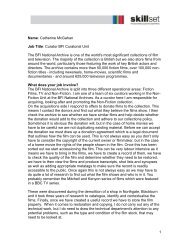Publishing in the Knowledge Economy - DTI Home Page
Publishing in the Knowledge Economy - DTI Home Page
Publishing in the Knowledge Economy - DTI Home Page
You also want an ePaper? Increase the reach of your titles
YUMPU automatically turns print PDFs into web optimized ePapers that Google loves.
<strong>Publish<strong>in</strong>g</strong> <strong>in</strong> <strong>the</strong> knowledge economy<br />
The <strong>in</strong>dustry today<br />
4.4 International comparisons of<br />
productivity and <strong>in</strong>novation<br />
We have noted already <strong>the</strong> scepticism with<br />
which <strong>in</strong>ternational comparisons should be<br />
treated. Figure 4.11 shows productivity <strong>in</strong>dices<br />
for publish<strong>in</strong>g <strong>in</strong> five countries dur<strong>in</strong>g <strong>the</strong> 1990s,<br />
based on data from <strong>the</strong> OECD, as compiled by<br />
<strong>the</strong> Gron<strong>in</strong>gen Growth and Development Centre<br />
<strong>in</strong> <strong>the</strong> Ne<strong>the</strong>rlands. Productivity is measured <strong>in</strong><br />
value added (1995 prices) per worker,<br />
unadjusted for hours worked. In addition <strong>the</strong> UK<br />
employment figure excludes <strong>the</strong> self-employed.<br />
For all countries <strong>the</strong> <strong>in</strong>dex is set to 100 <strong>in</strong> 1990,<br />
except for Germany (1991).<br />
The pattern of change <strong>in</strong> productivity across<br />
<strong>the</strong>se five countries is at variance with <strong>the</strong><br />
standard picture of economy-wide productivity<br />
growth <strong>in</strong> <strong>the</strong> 1990s. The US shows <strong>the</strong><br />
weakest productivity growth with <strong>the</strong> highest<br />
rates of growth <strong>in</strong> cont<strong>in</strong>ental Europe. The UK<br />
lies somewhere <strong>in</strong> between, show<strong>in</strong>g gentle<br />
growth <strong>in</strong> productivity. O<strong>the</strong>r <strong>in</strong>dustries covered<br />
<strong>in</strong> <strong>the</strong> Gron<strong>in</strong>gen <strong>in</strong>dices exhibit a more similar<br />
pattern to <strong>the</strong> standard one, so it would appear<br />
that <strong>the</strong> performance of publish<strong>in</strong>g is, <strong>in</strong> fact, at<br />
variance with <strong>the</strong> overall <strong>in</strong>ternational<br />
productivity picture. There are some possible<br />
explanations: US companies suffered from <strong>the</strong><br />
strong dollar <strong>in</strong> <strong>the</strong> second half of <strong>the</strong> 1990s,<br />
while conversely, Eurozone countries benefited<br />
from <strong>the</strong> weaken<strong>in</strong>g Euro. With its strengths <strong>in</strong><br />
scientific publish<strong>in</strong>g, <strong>the</strong> Ne<strong>the</strong>rlands has<br />
particularly benefited from <strong>the</strong> strong dollar, as<br />
has <strong>the</strong> German publish<strong>in</strong>g <strong>in</strong>dustry. There is<br />
o<strong>the</strong>r evidence from <strong>the</strong> Newspaper Association<br />
of America that <strong>the</strong>re was a cont<strong>in</strong>u<strong>in</strong>g decl<strong>in</strong>e<br />
<strong>in</strong> productivity <strong>in</strong> that part of <strong>the</strong> <strong>in</strong>dustry. We<br />
have also been told <strong>in</strong> a number of <strong>in</strong>terviews<br />
that <strong>the</strong> diffusion of new technology and more<br />
efficient work<strong>in</strong>g practices has perhaps not gone<br />
as far with<strong>in</strong> US newspaper publish<strong>in</strong>g as might<br />
be expected, and not as far as it has <strong>in</strong> <strong>the</strong> UK.<br />
It must be emphasised that this graph depicts<br />
growth trends, not absolute levels of<br />
productivity. Fur<strong>the</strong>r <strong>in</strong>ternational comparisons<br />
for sub-sectors of <strong>the</strong> <strong>in</strong>dustry are made <strong>in</strong> <strong>the</strong><br />
relevant sections of <strong>the</strong> report.<br />
Reliable figures for comparisons of <strong>in</strong>novation<br />
are even harder to f<strong>in</strong>d. The UK<br />
competitiveness <strong>in</strong>dicators uses data from <strong>the</strong><br />
second Community Innovation Survey (CIS)<br />
(Figure 4.12), but at <strong>the</strong> level of <strong>the</strong> <strong>in</strong>dustry this<br />
source becomes quite unreliable. ‘<strong>Publish<strong>in</strong>g</strong>’ is<br />
<strong>in</strong>cluded with pr<strong>in</strong>t<strong>in</strong>g and wood pulp and only<br />
133 firms <strong>in</strong> <strong>the</strong> UK are <strong>in</strong>cluded <strong>in</strong> <strong>the</strong> sample.<br />
It is also quite dated (from 1996-97 – although<br />
CIS 3 is currently under preparation) and so its<br />
relevance to 2002 must be taken with a p<strong>in</strong>ch of<br />
salt. The figure below shows <strong>the</strong> percentage of<br />
firms <strong>in</strong> each <strong>in</strong>dustry stat<strong>in</strong>g that <strong>the</strong>y<br />
<strong>in</strong>troduced a new or improved product with<strong>in</strong> <strong>the</strong><br />
last year. The percentage of UK firms <strong>in</strong> this<br />
category is above <strong>the</strong> average for <strong>the</strong> European<br />
Union (plus Norway) as a whole, but below <strong>the</strong><br />
figures for Germany and <strong>the</strong> Ne<strong>the</strong>rlands.<br />
Figure 4.13 illustrates <strong>the</strong> positive trade<br />
balance <strong>in</strong> pr<strong>in</strong>ted matter, which is <strong>the</strong> nearest<br />
available data to publish<strong>in</strong>g. The data is <strong>in</strong><br />
dollars – <strong>in</strong> national currency terms <strong>the</strong> picture<br />
for Germany and <strong>the</strong> Ne<strong>the</strong>rlands would look<br />
much better. Naturally this is not an ideal<br />
def<strong>in</strong>ition, and it also should be po<strong>in</strong>ted out that<br />
UK publishers have made <strong>the</strong> decision to pr<strong>in</strong>t<br />
a great deal of material abroad both for cost<br />
reasons and to facilitate access to third markets.<br />
28

















